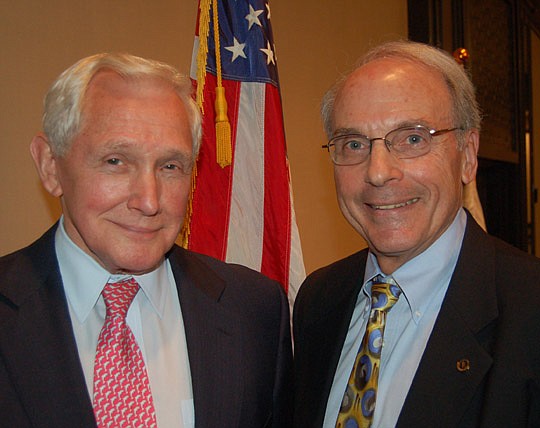
The Rotary Club of Jacksonville, celebrating its centennial year, maintained one of its longstanding traditions Monday when it hosted the president-elect of the American Medical Association, Dr. Jeremy Lazarus, at the club’s meeting at the Omni Hotel Downtown.
For more than 25 years, the club has each year invited the leadership from the AMA to visit Jacksonville and speak to the club about issues facing physicians and their patients.
Lazarus is a psychiatrist who practices in Denver and teaches at the University of Miami. He served as chair of the AMA Board of Trustees Compensation Committee and represented the medical association on the Health Coverage Coalition for the Uninsured.
Lazarus said the federal Patient Protection and Affordable Care Act represents “changes of a sweeping nature.” While the AMA supports health insurance reform and believes new laws are needed, “the law was far from perfect,” he said.
“It is the first step in improving our health care system,” Lazarus said.
Lazarus said that while no one can know how the U.S. Supreme Court will rule on the individual mandate portion of the Affordable Care Act, the AMA would be the “leading voice” to ensure that Americans can have the health care they deserve.
The mandate would require all individuals to pay for health insurance or pay a penalty.
Lazarus said the survey conducted by the Kaiser Family Foundation determined that less than half of Americans believe they understand the law.
Forty percent of households with a member with a pre-existing condition do not understand that under the Affordable Care Act, insurers would be prevented from denying them coverage, he said.
Other changes in health care include prohibiting insurance companies from canceling a policy because the insured made a mistake filling out the application and ensuring that insurance carriers would cover preventive treatments without an additional charge to the insured.
Lazarus said even under the current system, everyone contributes to cover the cost of the nation’s health care.
“We all pay, one way or another. Doctors pay, hospitals pay, insurance companies pay and employers pay,” said Lazarus.
He estimated that $1,000 of the annual premium paid by an insured person pays for the health care costs of people who do not have insurance.
No matter how the high court rules, the AMA supports the concept of individual responsibility, Lazarus said.
“If you can afford to pay for health insurance, pay. If you don’t, you should pay a fee,” he said.
“Market reform is predicated on getting more people into the insurance risk pool,” Lazarus said.
One criticism of health care reform is that the plan amounts to socialized medicine. Lazarus said that’s not accurate.
“Health care is still in the hands of doctors and their patients,” he said.
“No one will deny treatment to the old and the ill,” he said.
He recommended a website, healthcareandyou.org, a joint effort of the AMA and AARP, as a resource about the changes in the health care law.
Lazarus said the AMA remains committed to tort reform. He said data compiled by the association indicates that 61 percent of physicians over the age of 55 have been sued at least once and half of those physicians were sued before the age of 40.
He said that 100 percent of neurosurgeons practicing in South Florida have been sued.
However, 64 percent of claims against physicians are either dropped or dismissed, he said.
“The AMA is not interested in protecting incompetent physicians. We are interested in reducing frivolous lawsuits,” he said.
Another area of concern for the AMA is a predicted shortage of health care professionals. The shortage, estimated at as many as 150,000 physicians by 2025, will be particularly important considering the generation of 75 million baby boomers is starting to enter retirement.
“We need more physicians and more health care professionals of all types,” Lazarus said.
356-2466